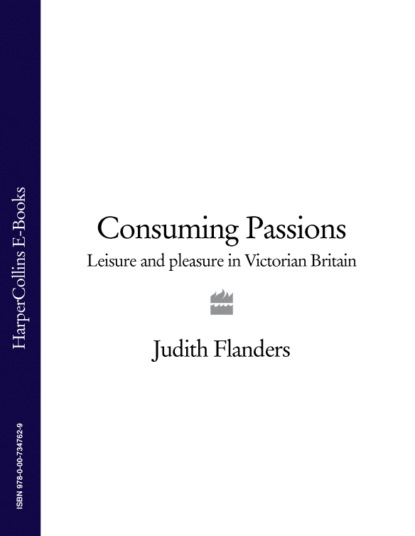
Полная версия:
Consuming Passions: Leisure and Pleasure in Victorian Britain
†An eighteenth-century idiom for ‘in order’.
*And the members soon struck lucky: among their earliest prizewinners was the adolescent Richard Cosway, who later became one of London’s most fashionable miniaturists.
*Thomas Cubitt (1788—1855) was the son of a carpenter. From small projects, his work expanded to encompass building housing on the Duke of Bedford’s land in Bloomsbury, moving on to develop over 8 hectares for Earl Grosvenor in what ultimately became Belgravia, the most fashionable district of London; he also developed much of Pimlico, and more than 100 hectares south of the river, in Clapham. He came to the attention of Prince Albert when Osborne House, the royal family’s home on the Isle of Wight, was to be rebuilt, although neither man can have imagined the family connection being sustained nearly two centuries later, when Albert’s great-great-great-great-grandson, Prince Charles, the Prince of Wales, married Cubitt’s descendant Camilla Parker Bowles.
*Lyon Playfair is almost as exhausting to contemplate as Cole: a chemist—the discoverer of nitro-prussides, a new class of salts—he was later Professor of Chemistry at Edinburgh University, Postmaster General, an MP, and Deputy Speaker of the House of Commons, interspersed with membership of the Royal Commission on Sanitation, advising on the ventilation of Buckingham Palace (his report was thought too alarming to be shown to Parliament), investigating the Famine in Ireland, producing research for the Geological Survey, advising on the promotion of technical education, sitting on the Royal Commission on cattle plague, and heading the commission inquiring into the civil service that finally replaced patronage with competitive examinations.
*Hats throughout the century attracted a range of gimmicks, mostly attempts to keep the head cool while still wearing the de-rigueur heavy felt-fur or silk and plush hats. Among many ideas patented were the ‘Bonafide Ventilating Hat’ (1849), a hat with an air-flow ventilator, or one with movable shutters (1880s), and the ‘Neoteric Ventilating Hat’ (1851), which had a woven frame of manila grass or willow. Another group of patents involved pads to keep the hat away from the head, improving ventilation while also preventing the fabric from becoming soiled by contact with the wearer’s hair oil: the ‘Gutta Percha Hat’ (1848) with rubber lining, which protected against both rain and perspiration; the ‘Aeolian Hat’ (1853), with an air pocket (‘In this way a completely encircling air chamber is formed to embrace the head, and making an easy pleasant fit and also preventing the natural grease from the hair penetrating to the exterior of the hat’); and the ‘Corrugated Ventilating Hat Antimacassar Pad’ (1863).26
*Mahogany had first been imported from Central America in the 1720s, and Sir Robert Walpole immediately had seats for his commodes made from this new luxury material.35
*It has been suggested that this lack of pricing was one of the reasons so many exhibits focused on technical ingenuity. If the main selling point of an object was that it was half the price that was usually charged, there was no point in showing it, without a price, at the Crystal Palace.
*For more on Layard, see p. 199.
†Navvies (from ‘navigators’) were originally the labourers who built the canals. By the 1850s, ‘navvy’ was shorthand for a labourer on the railways in particular. Navvies had a well-earned reputation for ferocious violence and drunkenness.
*The Early English Text Society’s founder, Frederick Furnivall (1825—1910), would have been thrilled. He was closely involved with adult education, teaching evening classes at the Working Men’s College when it opened in London in 1854.
*During the twenty-four weeks of the Exhibition, 1,092,337 bottles of soda water, lemonade and ginger beer were sold.
*Cassell went on to become the publisher of Cassell’s Magazine and Cassell’s Illustrated Family Paper, plus many other journals (see p. 157), as well as the first British edition of Uncle Tom’s Cabin. However he lacked business instincts, and his company was soon taken over by others, although his skills as a publishing entrepreneur were highly regarded, and the house of Cassell’s in various guises has survived into the twenty-first century.
*It was clear from the price that he was aiming at a working-class mass market: the Illustrated London News, which featured the Exhibition heavily in its pictures all summer long, sold for 6d. an issue.
†Only 200 words were given to the Exhibition itself, and it suggested that four hours would be plenty for the visitor to ‘do’ the fair.
*For more on advertising, see pp. 130—37; for W. H. Smith and newspaper distribution, pp. 145—6; for W. H. Smith and railway bookstalls, pp. 191—2.
Конец ознакомительного фрагмента.
Текст предоставлен ООО «ЛитРес».
Прочитайте эту книгу целиком, купив полную легальную версию на ЛитРес.
Безопасно оплатить книгу можно банковской картой Visa, MasterCard, Maestro, со счета мобильного телефона, с платежного терминала, в салоне МТС или Связной, через PayPal, WebMoney, Яндекс.Деньги, QIWI Кошелек, бонусными картами или другим удобным Вам способом.
Вы ознакомились с фрагментом книги.
Для бесплатного чтения открыта только часть текста.
Приобретайте полный текст книги у нашего партнера:
Полная версия книги
Всего 10 форматов



